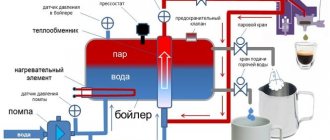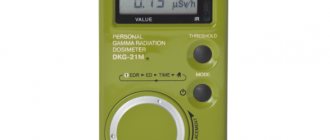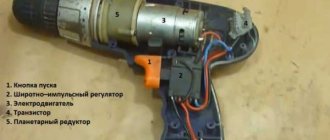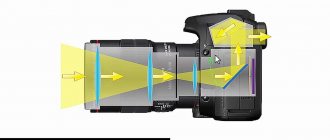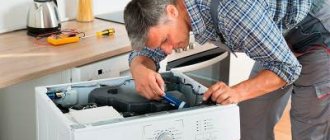Waste shredder device
A food waste chopper or disposer belongs to the category of equipment that works on the principle of crushing. To start a mechanical shredder, you do not need to connect to the power supply, you just need to open the water, it sets the knives in motion, which are located in the body.
An electric grinder is a two-level grinding of solid and large particles and bringing them into a homogeneous consistency that is easily washed off with water.
Two components are responsible for two-level grinding:
- Table with rotating trimming mechanism.
- Crushing ring.
The table rotates at speeds above 2000 rpm. The waste entering the mechanism through the neck of the disposer falls on the table and is thrown forcefully onto the crushing ring. There are cams on the table that scatter the particles and prevent them from sticking together.
The cycle occurs until the particles of debris pass through the opening of the device and go into the sewer, then they are easily washed away by the flow of water and do not form blockages.
The presence of a trimming mechanism prevents fibrous particles from getting into the gap between the table and the ring. With each turn, cutting occurs, the fibers become short and no longer clog the drain.
For the disposer to function, a flow of water is needed, which is turned on before starting the device; in addition to flushing waste, the water cools the engine, which heats up during operation. Without water, the chopper overheats and fails.
Food processor-chopper
All devices for cutting products can be divided into two large categories: mechanical and electrical. The kitchen manual chopper is powered by a person. Manual mills include all kinds of mills, vegetable cutters, and choppers. There is only one disadvantage of the devices - you have to make physical efforts to process the products. An electric food chopper for the kitchen is more popular as it operates from the mains.
Electric choppers for the kitchen
A kitchen food chopper with an electric motor has a simple design - a motor built into the lid, knife and container in which the food is placed. It can handle any source material. According to the cutting principle, electric kitchen choppers are divided into two types:
- Devices with rotating two knives - impellers.
- Devices with a rotating drum or disk equipped with notches of different sizes.
An electric kitchen chopper uses a blade to cut large or small pieces of food. It can work as a meat grinder and grater, scrolling ingredients through holes of attachments of various diameters and shapes. The device can work as a blender and mixes the initial ingredients until smooth; as a mixer, it can thoroughly beat everything.
Mechanical kitchen chopper
A manual kitchen food chopper operates using human effort. Products are placed in a bowl, slicing is done using the lid as a press or by rotating a small handle. Among the manual kitchen choppers, the most popular is the chopper. It is a bowl with a lid, inside there is a knife. Rotating, it grinds the ingredients. The kitchen chopper food chopper allows you to process coffee beans, cereals, nut kernels into flour, chop vegetables into equal slices, and mix the ingredients for dough.
Types and characteristics of waste shredders
Kinds
Mechanical. This is a design that contains knives; they are put into operation by a water flow. The devices are safe for humans - the cutting elements are located far from the drain hole. They work autonomously, without connecting to the mains.
Electrical . They only work when power is supplied. There are no cutting elements, but they operate on the principle of crushing. Due to the operation of the engine and moving components, such a disposer produces noise. In terms of efficiency it is inferior to mechanical.
The main function is to process waste to prevent the formation of blockages in sewer pipes - this is a modernized siphon that does not require regular cleaning.
Characteristics
Power .
The grinding speed and energy consumption of the device depend on this indicator. Dispensers with a power of up to 300 W are used at home; higher power is suitable for catering establishments. This figure varies between 500-800 W, the more powerful, the more expensive. Crushing chamber volume . It is directly dependent on the first indicator. The higher it is, the larger the chamber. Varies between 0.7 -1.5 liters.
Material of the chamber and cams (for electric) knives (for mechanical). Stainless steel is considered durable and reliable.
Loading type – continuous and batch. In the first case, first turn on the device and only then load waste into it. The portioned one is first loaded with garbage and then turned on. To load the next batch, the device must be turned off.
Weight and dimensions . Before choosing a disposer, you should compare the size of the unit with the free space under the sink. Weight depends on a number of characteristics and is never less than 7 kg.
Noise level . Depending on the type of waste processed, the noise level can be as high as that of a coffee grinder when grinding coffee.
Reverse . The presence of this function will protect the motor from overload.
Rotational speed . For mechanical, this indicator directly depends on the speed of the water flow. For electric, the minimum speed is not less than 1400 rpm. The faster the better.
Standard equipment
- Frame.
- Pneumatic button and pneumatic hose.
- Fastening lock.
- Rubber seals.
- Branch with outlet pipe.
- The service key is a hexagon.
Note! Depending on the type and manufacturer, the equipment may vary slightly.
Among the accessories that are needed for the disposer, it is worth highlighting the pneumatic button. It is mounted in a visible place - the countertop near the sink and over time may lose its presentable appearance.
Criterias of choice
There is no need to choose between an electric and hydraulic kitchen chopper for the sink in Russia: on the domestic market, the vast majority of models presented are equipped with an electric motor.
This is due to several reasons:
- Lower price.
- Higher performance. No matter how strong the pressure in the tap, the motor will still rotate the grinder disk faster than the water.
- Safety. Hydraulic disposers, due to the low rotation speed of the disk, use knives to shred waste, but there are no sharp blades inside an electric shredder.
Before purchasing a disposer:
- Check the diameter of the drain hole in the sink: it should be 90 mm. If the drain hole is smaller, it will need to be flared. To do this, it is better to call a specialist.
- Measure the distance inside the kitchen cabinet between the bottom of the sink bowl and the bottom of the cabinet. This will help you choose the dimensions of the device. Also keep in mind that there should be room in the kitchen cabinet for a trash can and possibly a water filter.
- Check out reviews of highly rated models. This will help you figure out which disposer is right for you.
When choosing a grinder for your kitchen sink, pay attention to the following criteria:
- Performance: how quickly the shredder will process waste. The characteristics of the device indicate the number of revolutions of the chopper disk per minute. The larger this number, the faster the disposer will do the job. A rotation speed of 1400 rpm is considered sufficient, but there are models with revolutions up to 2700 per minute. Productivity also depends on the usable volume of the shredder: the smallest ones have a chamber volume of 0.6 liters. For a family of 3-4 people, a disposer with a crushing chamber volume of 1.75 liters is suitable, for a family of 5-6 people – 2.25 liters. When choosing the dimensions of the chopper, take into account the available space under the sink: a disposer with the required chamber volume in terms of overall size may simply not fit into the kitchen unit.
- Noise level. When the disposer operates, it directly depends on what kind of waste is processed. Bones and nuts make a louder sound when disposed of than potato peelings. But this lasts from a few seconds to a minute depending on the volume being processed. Manufacturers indicate the maximum noise during operation of the chopper - it ranges from 40 to 45 dB. This is comparable to the operation of a dishwasher or refrigerator. Some models are equipped with an additional noise reduction system.
- Reliability. It depends on the materials from which the chopper parts are made. It is better to choose the body and crushing chamber from stainless steel. The automatic overload protection system will prevent the engine from burning out, and the protection against foreign objects will prevent damage to the working parts of the device.
The cost of electric stainless steel shredders ranges from 8 to 30 thousand rubles, depending on the manufacturer, power and dimensions.
Pros and cons of waste shredders
Advantages
Convenience . It is not necessary to clean waste from each plate, throw it into a disposer for recycling, and then into the sewer; the dishwashing process is accelerated. In addition, you can turn it on and off using a pneumatic button or simply turning on the water.
Reducing waste that goes to landfill. Due to the fact that leftover food can be processed and dumped into the sewer, the amount of organic waste in the trash can, and therefore in the city landfill, is reduced.
In addition, the absence of organic waste in the bucket will help get rid of unpleasant odors in the kitchen.
Elimination of blockages in the pipe, which means failure of the sewer system. This kind of recycling prevents rodents from infesting and living in sewer pipes.
Modern disposers are safe . Even a small child cannot get hurt.
If you live in a private house with individual sewerage and use a septic tank, then discharging food and crushed waste speeds up the process of processing sewage inside the septic tank.
Flaws
- Water consumption increases. On average 3 liters per day. Water is needed for the normal functioning of the unit - mechanical and electrical.
- Energy consumption increases. It depends on the power on average 0.3-0.8 kW/h.
- It is worth installing smooth, not corrugated pipes in the sewer system, otherwise small particles will get stuck in the corrugation.
- Some products cannot be crushed; before the waste is sent to the disposer, it must be sorted.
- The disadvantage is that it is not possible to dispose of all food residues, such as those that are slippery or too hard.
- The design and mechanisms of the shredder work properly, subject to proper installation and operation.
Reasons for contacting service centers
- Damage to the device due to incorrect installation. Possibility of leaking joints.
- Changes in the electrical network are the result of a burnout of the control unit.
- Clogging. This is more likely not a breakdown, but a feature of operation, as evidenced by a decrease in the grinding speed and “tight” operation.
How to choose a sink disposer?
It is important to understand how to choose a food waste disposer for your sink before you go to the store to purchase one.
The main parameter that you need to pay attention to when choosing a disposer is the power of the device. Not only the cost of the unit, but also its efficiency largely depends on this characteristic. Case size is also important to consider. The larger the cylinder, the greater the volume of debris that it can pass through itself in a certain period of time.
Advice! To prevent unpleasant odors from spreading from the kitchen sink drain hole, and to prevent harmful microorganisms from multiplying, it is better to choose a chopper with an antibacterial coating inside the body. .
Some disposer models are equipped with additional functions, which should also be taken into account when choosing a unit. First of all, this is the number of operating modes. The higher the speed, the more effectively it grinds waste of varying degrees of density. Some manufacturers equip disposers with several attachments to expand the list of shredded waste.
As for the best manufacturers of disposers, the most popular among users are several companies that have proven themselves well. Their products have their own characteristics, with inherent advantages and disadvantages:
- Bone Crusher shredders - their main difference from devices from other companies is that they are made not of metal, but of special high-strength plastic. Another important feature of these disposers is a separate button for turning the device on/off, which is mounted on the countertop next to the sink. The average cost of such a unit is approximately 20,000 rubles;
- models from Whirlpool and Bosch-Siemens are good household disposers for use at home; they cope well with any type of waste. The internal chambers are coated with a special antibacterial layer, so that stench does not spread from the drain hole of the sink. The cost of devices for grinding food waste from these manufacturers is slightly higher than from other companies, but the additional costs are worth it. The average price is $200-$300 US;
- Disposers from the manufacturer Franke have an important advantage: they are equipped with an excellent noise insulation system, that is, even when the device is operating at the highest power, the noise of the device is suppressed and is practically inaudible. This is very convenient if there are small children in a small apartment. Another excellent feature of Franke shredders is the presence of a pneumatic system, thanks to which waste is crushed immediately as it arrives, without waiting for the user to turn on the device. The average price is about 25,000 rubles;
- model range from the InSinkErator company - these disposers are equipped with automatic reverse, that is, if the device cannot crush the garbage, it returns it back to the chamber, so there will be no blockages in the pipes. The unit is capable of grinding waste down to the smallest particles and flushes it into the sewer system. The device turns on when you press a special button, and turns off when you release it. These models are also equipped with built-in overload protection, which will prevent overheating and engine combustion even if the permissible load is exceeded; the device will simply turn off. A pleasant advantage is the price of the device, which does not exceed 17,000 rubles.
Each consumer chooses the disposer model that suits him best. Some people trust only well-known brands, despite their high cost, while others care about the functionality of the devices; others, when choosing a shredder, are guided solely by the low cost of the unit. But in any case, when choosing, you should take into account the parameters of your kitchen sink.
Advice! Regardless of the manufacturer, when choosing a device, you should pay attention to the complete set of the chopper for the kitchen. It must necessarily include fasteners, special keys, rubber gaskets, an outlet outlet, a pneumatic hose with a pneumatic button and other mechanisms provided for by the design of the disposer.
How to choose a waste shredder
You need to decide how much work the disposer will have to do. And this already depends on the number of people living in the house. Example: for a family of 4 people, a disposer with a power of 300-400 W is enough.
When choosing, you need to rely on the noise level emitted by the device.
The selection factors are:
- Electrical connections. If this is not possible, then you should take a closer look at mechanical models.
- Pay attention to the material of manufacture and loading method. Stainless steel will last longer. And the loading depends on the amount of waste.
- Balance the available space under the sink with the size of the shredder. It should not be difficult to access, but it needs maintenance from time to time.
- The advantage is the presence of a function to stop work when forks, spoons, and knives get into the washing hole.
Which is better
To choose a quality disposer, consider the following factors:
- The mechanical one works slower and is started only by water, but it is capable of grinding a larger volume of waste, which means it is more practical. In addition, it makes much less noise during operation.
- It should be compact and not create inconvenience to the user.
- Safety comes first. Modern disposers of various types have a hand protection mechanism; even if you want to get to the grinding mechanism, you will not be able to do this.
- The power of the device must match your needs. You should not buy one that is too powerful, as you will waste extra money. For 1 person living in the house, the power is calculated at 100 kW.
- A device that is too high-speed has an increased noise level; if the noise level is important, then limit the chopper to 1500 rpm.
If this parameter does not matter, then purchase a so-called “bone breaker” with an indicator of 2700 rpm. Please note that the more revolutions, the higher the pressure on the chamber. - The crushing chamber should be made only of stainless steel - it is durable and will withstand intensive use.
- Additional functions, increased noise insulation, the ability to provide continuous load, reinforced drain flange, reverse, multi-stage grinding.
- Convenience will be provided by remote control and automatic security system.
What is a sink food waste disposer
This household appliance serves to grind waste that enters the sink, thereby making it easier for it to pass through the drain pipe. It is mounted at the outlet of the sink and operates from the mains. The main advantages of a food waste disposer for the sink are ease of operation and long service life (approximately 15 years). Below we will take a closer look at the operating principle of the device and the features of its installation.
A food waste disposer is installed at the outlet of the kitchen sink.
Working principle of a sink grinder
The food waste grinder (disposer) is a durable metal body of a cylindrical shape, inside of which there is a crushing disk. The disk rotates using an electric motor located at the bottom of the housing. Taking into account the environment in which the device has to operate, the disk is made of stainless steel, which is characterized by increased resistance to corrosion. This means that the sink waste disposer is not afraid of any aggressive substances that may be encountered in the kitchen.
For safe and long-term use of the shredder, place in it only those wastes that are specified in the operating rules
The process of shredding waste is very simple. They enter the chamber of the device through the drain hole of the sink, and then, under the influence of the centrifugal force of the disk, they are pressed against the walls of the cylinder and ground. For grinding, a special stationary grater is used, mounted on the inner walls of the device. From the shredder chamber, the waste flows directly into the sewer through the drain pipe.
Helpful advice! Do not be afraid that a fork or spoon caught in the drain hole will break the device. The shredder is designed in such a way that if a solid object hits it, the engine automatically turns off.
Design of a food waste shredder
Not only the usual push-button switch can serve as a switch, but also the chopper cover, which you simply need to turn to turn on the device.
How to use a chopper
Using a sink grinder is very simple, but for maximum efficiency and long-lasting operation, it is recommended to follow the following procedure:
- turn on the water;
- turn on the waste shredder;
- direct waste into the sink drain;
- turn off the shredder after its operation is completed, when the noise of the shredded waste subsides;
- After a short period of time, turn off the water.
The crushed waste along with the water flow is removed into the sewer system
There are also a number of things you shouldn't do to your shredder if you want it to last as long as possible. This mainly concerns items that cannot be thrown into the disposer:
- Metal, glass and plastic. They simply cannot be shredded, so avoid getting them down the drain.
- Plastic bags and other packaging containers. This also includes products made from rubber and other plastic materials that are difficult to grind. They do not grind properly and can clog the drain pipe.
- Threads, ropes and hair. These materials can easily wrap around the motor shaft and cause premature failure.
The socket for connecting the disposer must be grounded and equipped with moisture protection
How to choose a sink disposer? We will talk about this further.
Features of choosing a chopper
One of the main characteristics that you should pay attention to when choosing a kitchen sink grinder is the engine power. Not only the price of the device, but also its efficiency directly depends on this parameter. The size of the case is also of great importance. The larger it is, the greater the amount of waste passes through it per unit of time. Some models may have additional features, the presence of which is also worth paying attention to when choosing a disposer.
The button to turn on the chopper is built into the countertop next to the kitchen sink
Helpful advice! If you want to avoid the spread of unpleasant odors from the sink drain hole and prevent the growth of bacteria, then you should pay attention to disposers with a special antibacterial coating inside the body.
If you are planning to buy a food waste disposer for your sink, you should pay attention to the number of modes when choosing a model. Some of them involve several operating speeds for the most efficient grinding of waste of varying degrees of density.
Functional drawers with a hole in the middle leave space for a sink equipped with a food waste disposer
By the way, many modern manufacturers also produce models with different numbers of attachments. This significantly expands the range of waste that can be crushed using the device.
The ideal option for a food waste shredder for the sink, which you can buy for your home, is a model with increased noise insulation, built-in automatic overload protection, a reverse rotation function and a special antibacterial coating inside.
For free movement of food waste into the sewer system, when connecting the disposer, use pipes with smooth walls
Exploitation
Operation of the disposer begins after installation:
- Installation takes place under the sink, and the pipe outlets are connected to the sewer pipe.
- For an electric disposer, you need to connect to the mains and connect the pneumatic button to the kitchen countertop.
- To connect to the sewer, you do not need to use a corrugated pipe; it will make it difficult for even crushed waste to pass through.
- The drain hole of the sink should have a diameter of 89-90 mm - this is the European standard. If it is less you need to increase it.
Installation steps step by step:
- Disconnecting the pipes that lead to the sink and cleaning the drain channels.
- A rubber gasket, included in the kit, is placed under the sink flange.
- Attachment to the mounting part of the disposer using the supplied parts.
- Attaching the chopper to the mounting hardware.
- Connecting sewer pipes to the grinder drain pipe. Adapters may be needed.
- The other end is connected to the sewer outlet.
- Placing the button on the tabletop and connecting.
Note! Detailed instructions with pictures and a description of the process are included with each device.
For uninterrupted and long-term operation of the disposer, it must be used correctly and at the same time adhere to the following rules:
- Before turning on the device, turn off the water tap.
- You need to load waste in portions.
You can recycle: food waste, including vegetables, fruits, watermelon rinds, eggshells. Chicken and fish bones (small), pasta, cereals, fruit seeds, nut shells. Cigarette butts, napkins and disposable towels (paper).
The following cannot be loaded into the shredder: non-food waste, large bones, and meat tendons. Do not throw away banana peels and corn cobs. Threads, hair, plastic bags, onion skins (steamed), hot fat or melted butter.
To prevent operational problems, the disposer needs to be cleaned. In particular, if unsuitable products and objects got inside. Maintenance is required if there is difficulty in operation, a drop in speed and waste processing speed.
Advice! The best prevention for a shredder is regular use.
There are no special precautions when working with the disposer. Due to its thoughtful and safe design, it will not cut your hands.
What kind of waste does a kitchen recycler process?
Shredder manufacturers recommend using disposers for almost all waste , including:
- fruits and vegetables;
- rinds of watermelons, melons, pumpkins;
- chicken and fish bones;
- any cereals, bakery and pasta products;
- shells of all types of nuts;
- napkins and cigarette butts.
There is a long list of items that should not be thrown down the drain in hopes of being shredded in a disposer.
First of all, these are different:
- films;
- plastics;
- fabrics;
- rubber and metal products;
- products with long fibers or strands;
- hair.
Disposing of the listed materials into the disposer will result in equipment failure.
As a rule, all disposers are equipped with a locking system. This means that if a foreign object or too hard bone gets into it, a system is activated that turns off the device.
Guarantee
The duration of the warranty for the “Food Chopper” product varies and depends on the manufacturer. On average it is 3-6 years. This period speaks for itself, because it confirms the quality, especially when compared with the average warranty period for other household appliances of 1-2 years.
Warranty service is provided with a properly completed warranty card. It must contain the date of purchase, name of the product, seal of the trade organization and its name, signature of the buyer and seller. The guarantee must be accompanied by a check or other document confirming payment.
Attention! You have the right to free replacement of parts, components or the entire product during the warranty period, but only if a manufacturing defect is detected and provided that the shredder was operated in accordance with the rules specified in the instructions.
Not covered under warranty:
- Replacement of consumables - rubber seals, linings, pneumatic buttons.
- Damage to the disposer as a result of improper operation, including incorrect installation. To prevent this from happening, install the shredder in accordance with the instructions.
The warranty is void in the following cases:
- Detection during inspection at the service center of damage that occurred during operation, installation or transportation.
- The disposer was damaged intentionally or as a result of a natural disaster.
- The water flow is not stable.
- There are traces of limescale or dirt on the surface.
- Installation and/or repairs were carried out unqualified.
- The disposer is not used for its intended purpose.
If you use the chopper correctly, then its breakdown, and therefore a call to the service center for a warranty claim, is unlikely.
Malfunctions
Cleaning - removing blockages . Although the device combats the formation of blockages in the sewer, it itself needs to be cleaned from time to time. You can normalize its operation with your own hands.
Before you start disassembling, you need to look at the diagrams in the instructions. If the installation was done by yourself, then there will be no problems with disassembly.
The tool you need is a hexagon, which is included in the package; it should be stored next to the disposer.
Sequence of work:
- The chopper is turned off by an automatic switch.
- First you need to shine a light inside and see what clogged the device.
- If possible, you can remove the lid in the sink.
- A hex wrench or wooden spoon is inserted into the grinder and the probe is used to search for blockages. If a bone or other hard object is found, it must be pushed into the sewer pipe.
- After this, testing is carried out; if the operation is normalized, it means that the blockage was eliminated.
- If performance does not improve, turn off the power and check for blockages in the outlet hose under the sink. It's also worth cleaning the holes there.
Leaking hoses . The situation can be corrected by changing rubber bands or seals if there is a leak at the joints. If there is a problem with the hose, it needs to be replaced.
Advice! Run your hand over all connections, seals, drain pipes, if there is a leak there, tightening the bolts or replacing the seals will help.
Problems with the flywheel . Characteristic features:
- Leaking from the bottom of the disposer. In this case, the flywheel needs to be replaced.
- The wheel doesn't spin. In this case, you cannot turn on the shredder for more than 10 seconds - this will lead to overheating of the motor.
Turn off the power to the device, use a hex wrench to loosen the flywheel and remove any debris that has gotten there. If the problem persists, you need to unscrew the wheel completely and get to the trimming mechanism. If there is a blockage, remove it.
It would be a good idea to sharpen the blades if this is not prohibited by the instructions.
Depending on the type of breakdown, you will need the following spare parts for self-repair:
- O-rings and gaskets.
- Hose and/or pipe.
- Flywheel.
Other problems in the operation of the shredder should be left in the hands of professionals.
Manufacturers
BONE CRUSHER
The manufacturer BONE CRUSHER specializes in the production of shredders. The American company has established itself with high quality and a selection of food dispensers with different capacities and tank volumes - there are domestic and industrial models.
Ergonomic shape and laconic design, reliability – these are the main characteristics of the brand.
Franke
Franke manufacturer specializes in producing a large range of household appliances - hobs, dishwashers, ovens, refrigerators, microwave ovens.
The list of products includes sorting systems, washing systems, mixers and waste shredders. The latter are electric, they are compact and do not interfere with the design of the kitchen, as they are mounted under the sink. They are safe and easy to use.
There are models with additional functionality in the form of odor suppressors, auto reverse, built-in air cleaners. The devices are treated with anti-corrosion compounds, which reduces the noise level during operation.
In-Sink-Erator
Just a fact: 86% of waste shredders sold in the world are products from the In-Sink-Erator brand. An American company that specializes in the production of dispensers and produces some kitchen appliances.
The product warranty reaches 6 years, which is a record among equipment of this type. The range includes household and industrial appliances
Midea
Midea is a well-known global manufacturer of household appliances: large and small, built-in. Household and industrial appliances are produced with different capacities. There is protection against motor overheating (reverse), prevention of jamming, a multi-stage processing system, anti-corrosion coating, low noise level.
Pyramis
Pyramis is a Greek manufacturer of kitchen appliances that has established itself throughout the world. The manufacturer understands the needs in the kitchen, and its products include choppers. Produces high-speed devices with batch loading. They are convenient and easy to use.
Seaman
Seaman specializes in the production of sanitary ware (sinks, faucets, grinders, accessories) made of stainless steel. This guarantees reliability and durability. There is automatic overload protection and sound insulation. Product warranty is 3 years.
STATUS
STATUS produces power tools. Characterized by quality and thoughtful design. The range includes: drills and screwdrivers, paint sprayers, range finders, vacuum cleaners, food waste grinders and much more.
Disposers can be mounted under a sink made of the thinnest metal or artificial stone. There is a step-by-step waste recycling system, noise insulation, and an overload protection system. 5 year warranty.
Weissgauff
Weissgauff produces household appliances and accessories, a German brand. Assortment: ovens, washing machines, built-in appliances, hobs, hoods and more.
The brand offers shredders of different capacities. The package includes a protective grille and a universal pusher; the device has overload protection.
Types and principle of operation
Next, we will describe the operating principle of a food waste shredder and a food destroyer for the sink, or, as it is also called, a disposer.
The vast majority of disposer models are equipped with an electric drive . But mechanical models that operate under the influence of water pressure are also used.
How do mechanical models work?
For successful operation of mechanical shredders, a water pressure of at least 4 bar is required. With a normally functioning plumbing system, this is the actual water pressure in the tap.
But the pressure indicator does not depend on the residents; a decrease in water pressure is especially often observed on the upper floors of houses.
Of course, the shredder will have no effect if the water pressure in the tap is low.
Electric shredders
Electric kitchen dispensers are in greatest demand.
The dispenser equipped with an electric drive does not depend on the water pressure in the tap . It just needs to be launched by pressing a button.
Batch loading models load waste first. With continuous loading, the shredder is started first, and then waste is placed into it for shredding.
There are also automatic models that do not require pressing a button, but turn on when waste gets into them.



